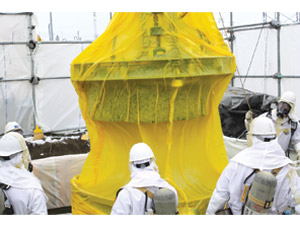A 55-in.-dia cut into a rebar-reinforced underground concrete tank with hardened nuclear waste, the largest slice ever into such a U.S. Energy Dept. storage structure, went “perfectly” on Dec. 19, says a site cleanup official.

In what may become the norm at DOE’s Hanford site in eastern Washington state and possibly at other U.S. waste sites, crews from Boston-based AK Services used a pressurized mix of garnet and water to methodically etch away the 172-in. circumference of the tank, says Kent Smith, deputy manager of retrieval and closure operations for Washington River Protection Services, a site contractor.
The 1940s-era tank still holds 247,000 gallons of radioactive and hazardous wastes. It is one of 149 thinner-shelled tanks on-site, and while not one known to have previously leaked contents, about 67 other tanks there have. The hole allows insertion of the large robotic arm in the tank that DOE hopes will remove 99% of waste remnants, some of it almost rock-like in consistency.
After two mock-ups of the cut and “several months of design and technology selection,” the operation was completed in 25 hours. “There was no release of any kind of contamination, no injuries, and [it went] right on the schedule we thought,” Smith says. Crews began by drilling a pilot hole through a concrete dome. Then, at a rate of eight inches per hour—“a very deliberate rate,” he says—a constant stream of the water-garnet mixture at a pressure of 48,000 psi pierced the 15- to 20-in.-thick concrete.
To avoid radioactive air pollution during the cut, crews placed the ring-guide assembly, powered by hydraulic pressure, inside a tent and operated remotely from 50 yd away. AK Services designed the unit with four nozzles to avoid having to return to the space during the cut. But only one was needed, and the air remained pure, says Carl Franson, AK Services vice president. As temperatures dipped below freezing during the cut, airline antifreeze allowed the cutter to move consistently. A new riser, with a shield plug, was immediately bolted in, sealing the hole.
The robotic arm, known as the mobile arm retrieval system, is set for installation in late February. The operation to remove remaining tank waste to a newer and more secure on-site double-shell tank is set to start in July.


Post a comment to this article
Report Abusive Comment